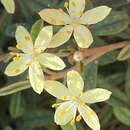mk
имиња во трошки


Asterolasia hexapetala is a species of erect, spreading shrub that is endemic to the Warrumbungles in New South Wales. It has oblong to elliptical leaves with star-shaped hairs, especially on the lower surface, and white flowers arranged in small groups in leaf axils and on the ends of branchlets, the back of the petals densely covered with white, yellow or brown, woolly star-shaped hairs.
Asterolasia hexapetala is an erect, spreading shrub that typically grows to a height of 3 m (9.8 ft). The leaves are oblong to elliptical, 30–60 mm (1.2–2.4 in) long and 5–15 mm (0.20–0.59 in) wide on a petiole 5–15 mm (0.20–0.59 in) long. The leaves are covered with white to brownish, woolly, star-shaped hairs, usually paler and more densely covered on the lower surface. The flowers are arranged in small umbels in leaf axils and on the ends of branchlets, each flower on a pedicel 5–20 mm (0.20–0.79 in) long. The five petals are white to yellow, mostly 7–9 mm (0.28–0.35 in) long, densely covered with white to yellow or brown, woolly, star-shaped hairs on the back. Flowering occurs in spring.[2][3][4]
This species was first formally described in 1825 by French botanist Antoine Laurent de Jussieu, who gave it the name Phebalium hexapetalum.[5][6] In 1917, George Claridge Druce changed the name to Asterolasia hexapetala.[7] The name originates from the Ancient Greek words; aster, lasios, and hexapetala, meaning star, hairy (referring to hairs on the leaves), and six-petals.
This asterolasia is only found in the Warrumbungle Ranges where it mainly grows along watercourses in forest and woodland.[2][3]
Asterolasoa hexapetala prefers a moist, well drained and lightly shaded situation. Established plants are able to cope with dry periods. Plants may be propagated by cuttings or from seed, with some difficulty.[4]
 Yellow form
Yellow form Asterolasia hexapetala is a species of erect, spreading shrub that is endemic to the Warrumbungles in New South Wales. It has oblong to elliptical leaves with star-shaped hairs, especially on the lower surface, and white flowers arranged in small groups in leaf axils and on the ends of branchlets, the back of the petals densely covered with white, yellow or brown, woolly star-shaped hairs.
Asterolasia hexapetala, es una especie de arbusto perteneciente a la familia de las rutáceas. Es un endemismo de Warrumbungles en Nueva Gales del Sur en Australia.
Asterolasia hexapetala alcanza un tamaño de alrededor de 1,5 metros de altura, se encuentra principalmente cerca del agua en el bosque esclerófilo y en los bosques en altitudes más bajas.
Las hojas son de color verdoso cubiertas de pelo, de 2-6 centímetros de largo, y alrededor de 1-2 centímetros de ancho. La flores miden 1-1,5 centímetros de diámetro, generalmente de color blanco o blanco amarillento, con estambres amarillos y rara vez creciendo en racimos. La fruta de Asterolasia hexapetala tiene la estructura de una baya, de color marrón, y crece junto a la flor.
La especie prefiere una situación húmeda, bien drenada y con ligera sombra. Las plantas ya establecidas son capaces de hacer frente a periodos de sequía. Las plantas pueden ser propagadas por estacas o semillas, con cierta dificultad.[1]
Asterolasia hexapetala fue descrita formalmente por primera vez por el botánico francés Antoine Laurent de Jussieu en 1825, quien le dio el nombre de Phebalium hexapetalum. La especie fue transferida al género Asterolasia en 1917 por el botánico inglés George Claridge Druce.[2] y publicado en Botanical Society and Exchange Club of the British Isles 4: 606, en el año 1916.[3]
El nombre deriva de las palabras del griego antiguo: aster, lasios y hexapetala, que significa = estrella peluda (en referencia a los pelos de las hojas), y con seis pétalos.
Asterolasia hexapetala, es una especie de arbusto perteneciente a la familia de las rutáceas. Es un endemismo de Warrumbungles en Nueva Gales del Sur en Australia.
Asterolasia hexapetala là một loài thực vật có hoa trong họ Cửu lý hương. Loài này được (A.Juss.) Druce mô tả khoa học đầu tiên năm 1916 publ. 1917.[1]
Asterolasia hexapetala là một loài thực vật có hoa trong họ Cửu lý hương. Loài này được (A.Juss.) Druce mô tả khoa học đầu tiên năm 1916 publ. 1917.